MERCEDES-BENZ B-CLASS HATCHBACK 2008 Owner's Guide
Manufacturer: MERCEDES-BENZ, Model Year: 2008, Model line: B-CLASS HATCHBACK, Model: MERCEDES-BENZ B-CLASS HATCHBACK 2008Pages: 305, PDF Size: 5.1 MB
Page 31 of 305
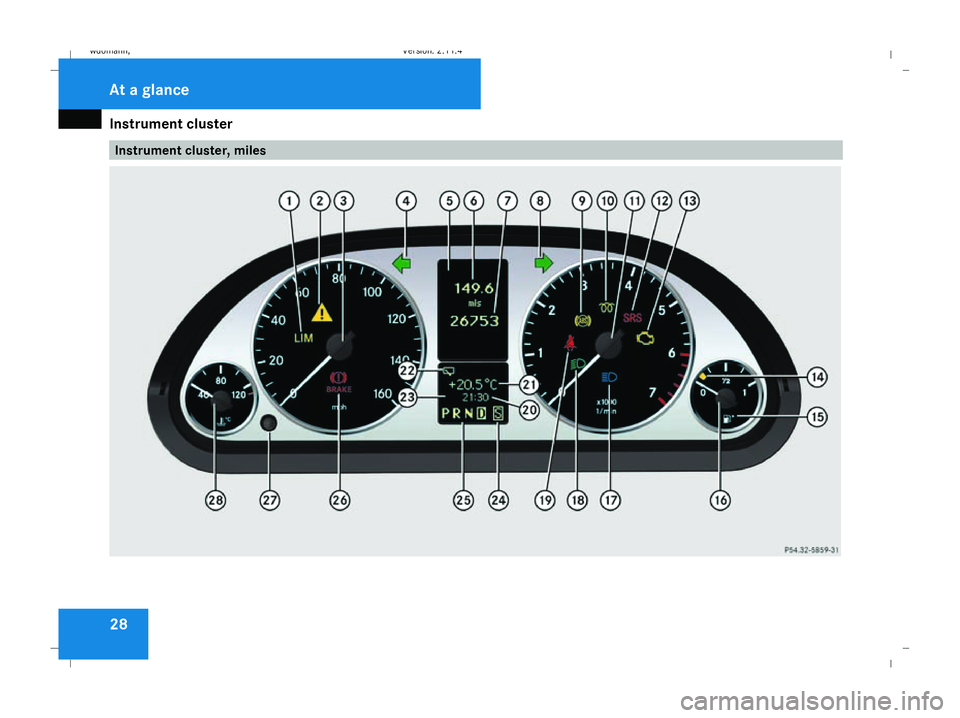
Instrument cluster
28 Instrument cluster, milesAt a glance
245_AKB; 2; 7, en-GB
wdomann
,V ersion: 2.11.4
2008-10-17T11:22:31+02:00 - Seite 28 Dateiname: 6515_1640_02_buchblock.pdf; preflight
Page 32 of 305
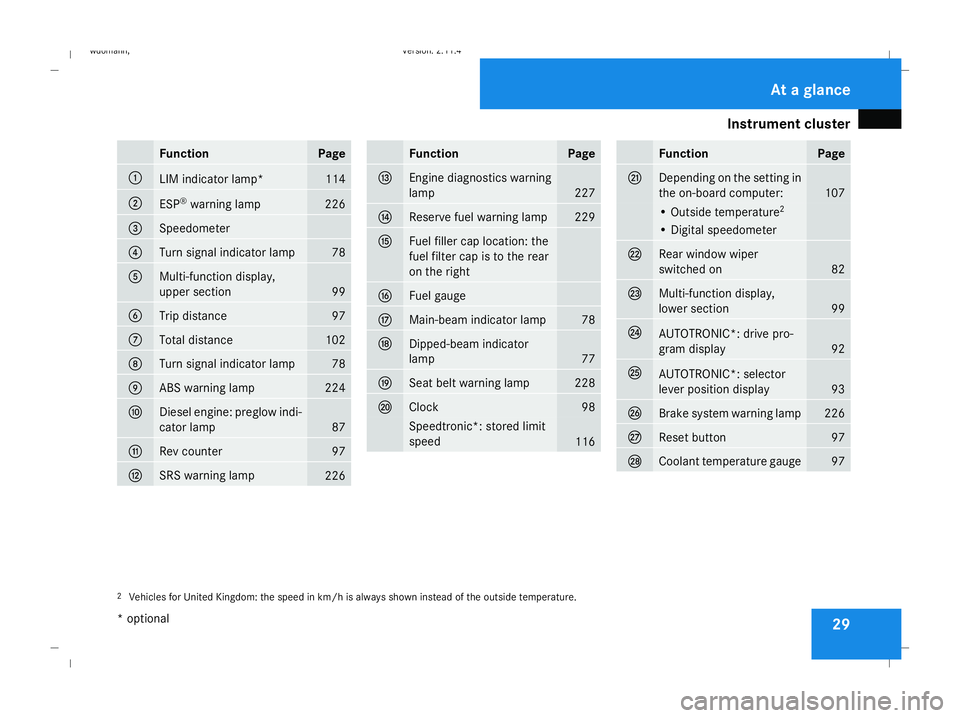
Instrument cluster
29Function Page
1
LIM indicator lamp* 114
2
ESP
®
warning lamp 226
3
Speedometer
4
Turn signal indicator lamp 78
5
Multi-function display,
upper section
99
6
Trip distance 97
7
Total distance 102
8
Turn signal indicator lamp 78
9
ABS warning lamp 224
a
Diesel engine: preglow indi-
cator lamp
87
b
Rev counter 97
c
SRS warning lamp
226 Function Page
d
Engine diagnostics warning
lamp
227
e
Reserve fuel warning lamp 229
f
Fuel filler cap location: the
fuel filter cap is to the rear
on the right
g
Fuel gauge
h
Main-beam indicator lamp 78
j
Dipped-beam indicator
lamp
77
k
Seat belt warning lamp 228
l
Clock 98
Speedtronic*: stored limit
speed
116 Function Page
m
Depending on the setting in
the on-board computer:
107
• Outside temperature
2 • Digital speedometer
n
Rear window wiper
switched on
82
o
Multi-function display,
lower section
99
p
AUTOTRONIC*: drive pro-
gram display
92
q
AUTOTRONIC*: selector
lever position display
93
r
Brake system warning lamp 226
s
Reset button 97
t
Coolant temperature gauge 97
2
Vehicles for United Kingdom: the speed in km/h is always shown instead of the outside temperature. At a glance
* optional
245_AKB; 2; 7, en-GB
wdomann
,V ersion: 2.11.4
2008-10-17T11:22:31+02:00 - Seite 29 Dateiname: 6515_1640_02_buchblock.pdf; preflight
Page 33 of 305
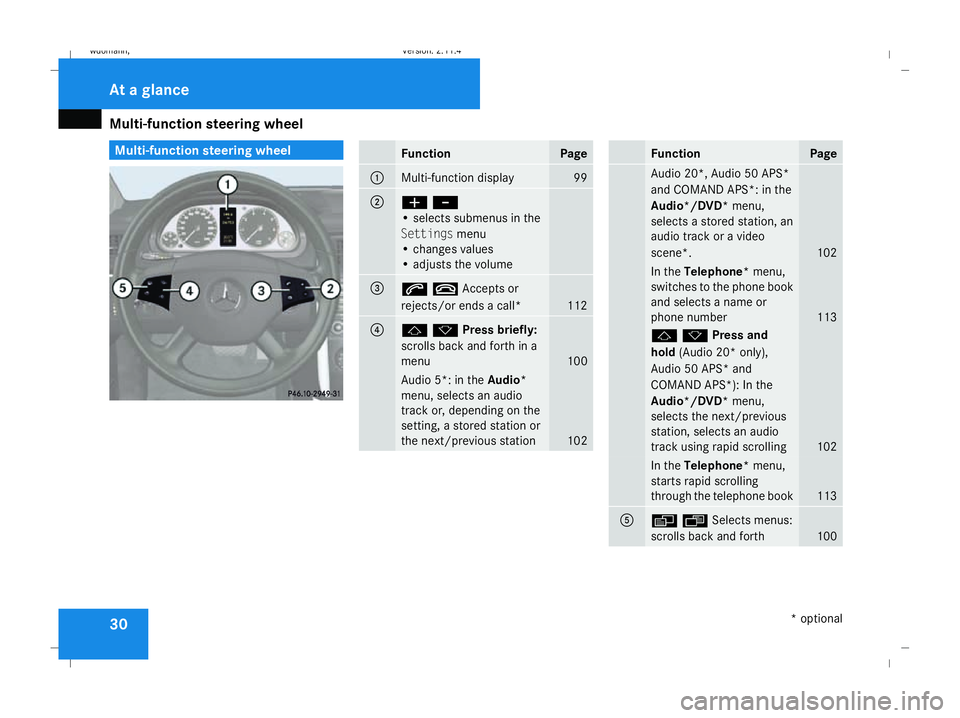
Multi-function steering wheel
30 Multi-function steering wheel
Function Page
1
Multi-function display 99
2
æ
-
• selects submenus in the
Settings menu
• changes values
• adjusts the volume 3
stAccepts or
rejects/or ends a call*
112
4
jkPress briefly:
scrolls back and forth in a
menu
100
Audio 5*: in the
Audio*
menu, selects an audio
track or, depending on the
setting, a stored station or
the next/previous station 102 Function Page
Audio 20*, Audio 50 APS*
and COMAND APS*: in the
Audio*/DVD*
menu,
selects a stored station, an
audio track or a video
scene*. 102
In the
Telephone* menu,
switches to the phone book
and selects a name or
phone number 113
jkPress and
hold
(Audio 20* only),
Audio 50 APS* and
COMAND APS*): In the
Audio*/DVD* menu,
selects the next/previous
station, selects an audio
track using rapid scrolling 102
In the
Telephone* menu,
starts rapid scrolling
through the telephone book 113
5
èÿSelects menus:
scrolls back and forth
100At a glance
* optional
245_AKB; 2; 7, en-GB
wdomann,
Version: 2.11.4 2008-10-17T11:22:31+02:00 - Seite 30Dateiname: 6515_1640_02_buchblock.pdf; preflight
Page 34 of 305

Centre console
31Centre console
Upper section Function Page
1
Switches the hazard warn-
ing lamps on/off
79
2
5
PASSENGER AIRBAG
OFF warning lamp* 45
3
Controls COMAND APS*
and the audio system* –
see the respective operat-
ing instructions
4
Controls Heatmatic, the air-
conditioning system* or
Thermotronic*
128
Switches the rear window
heating on/off
139
5
Activates/deactivates the
seat heating* for the right-
hand seat
68
6
Activates/deactivates the
ECO start/stop function*
126
7
Primes/deactivates the
interior motion sensor*/
tow-away protection*
58 Function Page
8
Deactivates/activates
Parktronic*
121
9
Activates/deactivates the
seat heating* for the left-
hand seat
68At a glance
* optional
245_AKB; 2; 7, en-GB
wdomann,
Version: 2.11.4 2008-10-17T11:22:31+02:00 - Seite 31Dateiname: 6515_1640_02_buchblock.pdf; preflight
Page 35 of 305
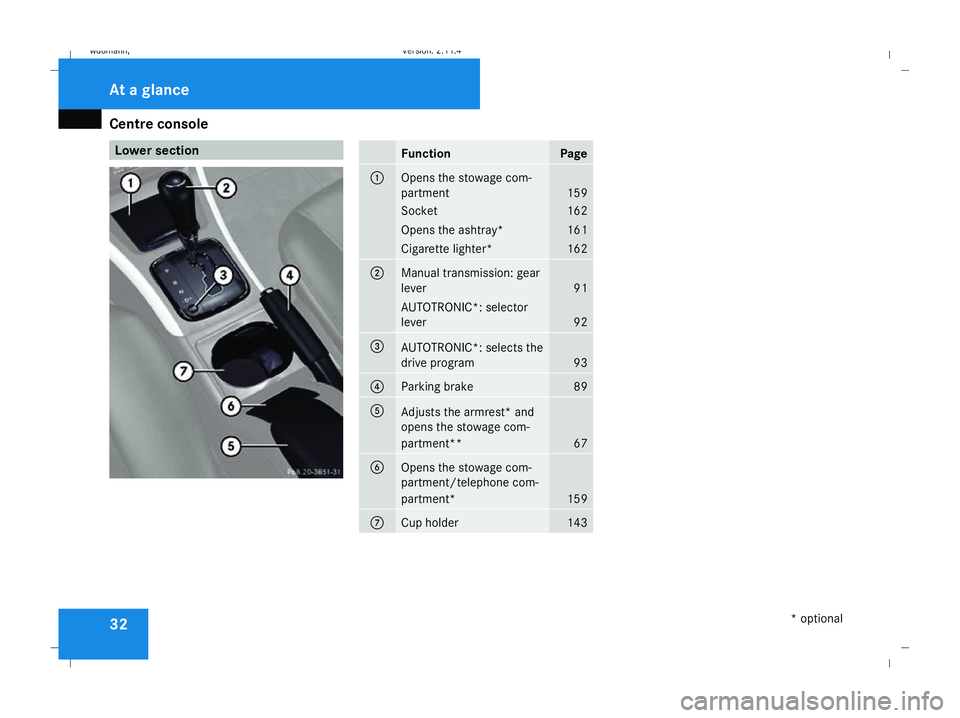
Centre console
32 Lower section
Function Page
1
Opens the stowage com-
partment
159
Socket 162
Opens the ashtray* 161
Cigarette lighter* 162
2
Manual transmission: gear
lever
91
AUTOTRONIC*: selector
lever
92
3
AUTOTRONIC*: selects the
drive program
93
4
Parking brake 89
5
Adjusts the armrest* and
opens the stowage com-
partment**
67
6
Opens the stowage com-
partment/telephone com-
partment*
159
7
Cup holder 143At a glance
* optional
245_AKB; 2; 7, en-GB
wdomann,
Version: 2.11.4
2008-10-17T11:22:31+02:00 - Seite 32 Dateiname: 6515_1640_02_buchblock.pdf; preflight
Page 36 of 305
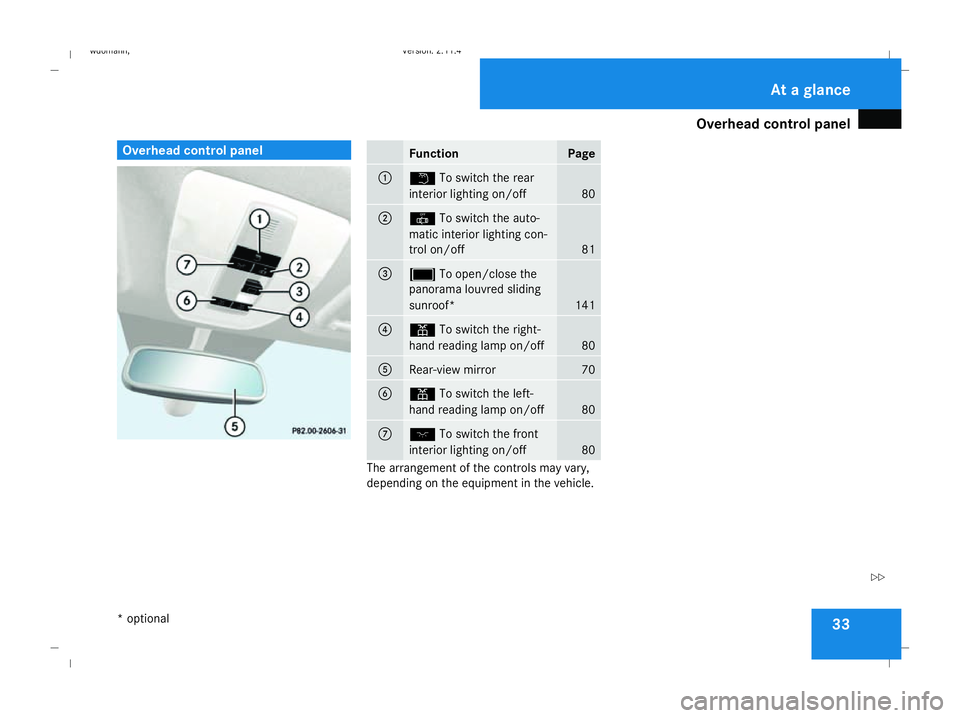
Overhead control panel
33Overhead control panel
Function Page
1
£
To switch the rear
interior lighting on/off 80
2
¥
To switch the auto-
matic interior lighting con-
trol on/off 81
3
a
To open/close the
panorama louvred sliding
sunroof* 141
4
X
To switch the right-
hand reading lamp on/off 80
5
Rear-view mirror 70
6
X
To switch the left-
hand reading lamp on/off 80
7
ð
To switch the front
interior lighting on/off 80
The arrangement of the controls may vary,
depending on the equipment in the vehicle. At a glance
* optional
245_AKB; 2; 7, en-GB
wdomann ,V ersion: 2.11.4
2008-10-17T11:22:31+02:00 - Seite 33 ZDateiname: 6515_1640_02_buchblock.pdf; preflight
Page 37 of 305
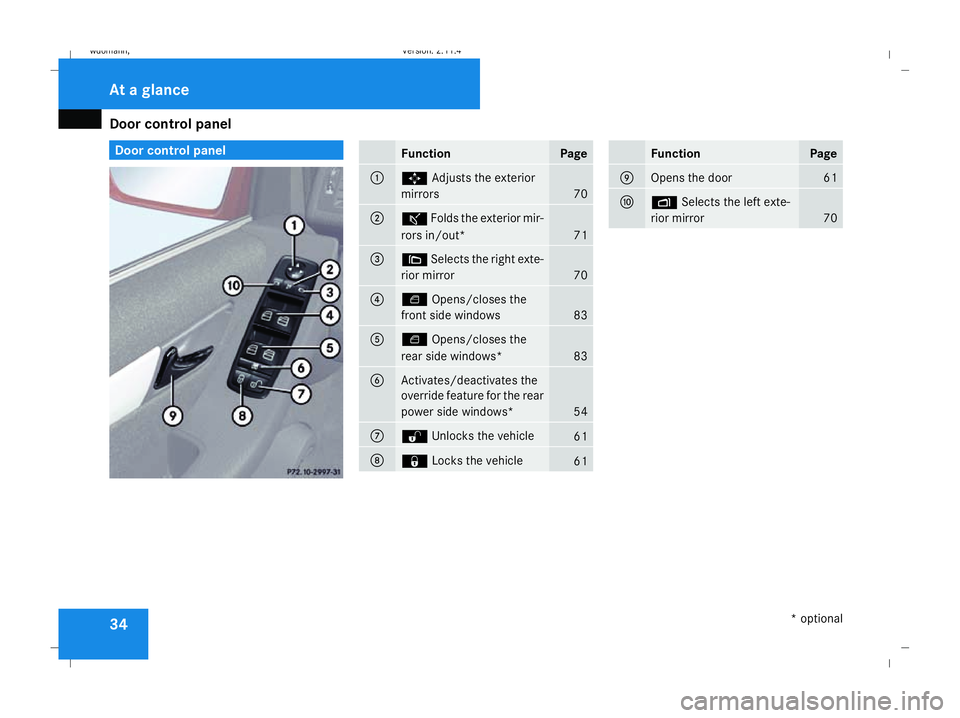
Door cont
rol panel 34 Door control panel
Function Page
1
r
Adjusts the exterior
mirrors 70
2
Z
Folds the exterior mir-
rors in/out* 71
3
&
Selects the right exte-
rior mirror 70
4
=
Opens/closes the
front side windows 83
5
=
Opens/closes the
rear side windows* 83
6
Activates/deactivates the
override feature for the rear
power side windows*
54
7
k
Unlocks the vehicle 61
8
j
Locks the vehicle 61 Function Page
9
Opens the door 61
a
%
Selects the left exte-
rior mirror 70At a glance
* optional
245_AKB; 2; 7, en-GB
wdomann
, Version: 2.11.4 2008-10-17T11:22:31+02:00 - Seite 34Dateiname: 6515_1640_02_buchblock.pdf; preflight
Page 38 of 305
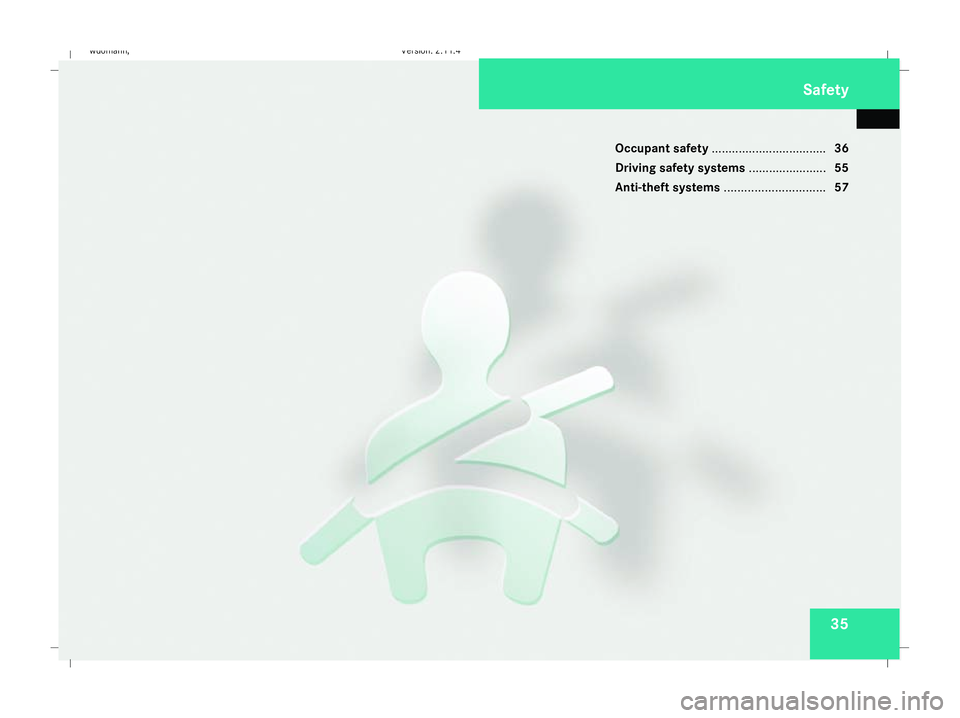
35
Occupant safety
.................................. 36
Driving safety systems .......................55
Anti-theft systems .............................. 57
Safety
245_AKB; 2; 7, en-GB
wdomann
,V ersion: 2.11.4
2008-10-17T11:22:31+02:00 - Seite 35 Dateiname: 6515_1640_02_buchblock.pdf; preflight
Page 39 of 305
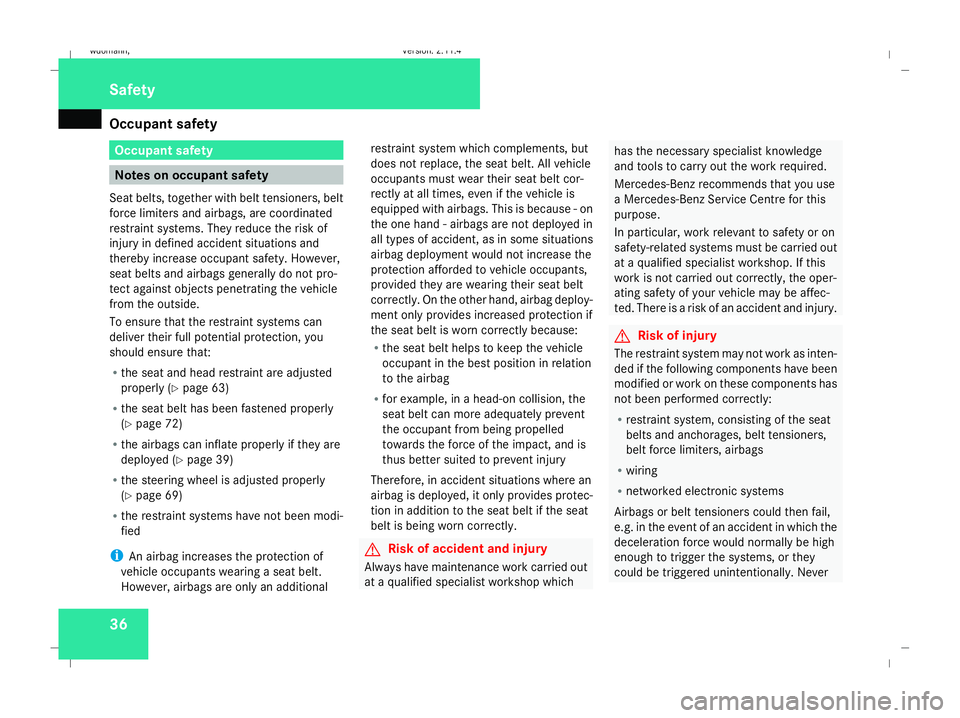
Occupant safety
36 Occupant safety
Notes on occupant safety
Seat belts, together with belt tensioners, belt
force limiters and airbags, are coordinated
restraint systems. They reduce the risk of
injury in defined accident situations and
thereby increase occupant safety. However,
seat belts and airbags generally do not pro-
tect against objects penetrating the vehicle
from the outside.
To ensure that the restraint systems can
deliver their full potential protection, you
should ensure that:
R the seat and head restraint are adjusted
properly (Y page 63)
R the seat belt has been fastened properly
(Y page 72)
R the airbags can inflate properly if they are
deployed (Y page 39)
R the steering wheel is adjusted properly
(Y page 69)
R the restraint systems have not been modi-
fied
i An airbag increases the protection of
vehicle occupants wearing a seat belt.
However, airbags are only an additional restraint system which complements, but
does not replace, the seat belt. All vehicle
occupants must wear their seat belt cor-
rectly at all times, even if the vehicle is
equipped with airbags. This is because - on
the one hand - airbags are not deployed in
all types of accident, as in some situations
airbag deployment would not increase the
protection afforded to vehicle occupants,
provided they are wearing their seat belt
correctly. On the other hand, airbag deploy-
ment only provides increased protection if
the seat belt is worn correctly because:
R
the seat belt helps to keep the vehicle
occupant in the best position in relation
to the airbag
R for example, in a head-on collision, the
seat belt can more adequately prevent
the occupant from being propelled
towards the force of the impact, and is
thus better suited to prevent injury
Therefore, in accident situations where an
airbag is deployed, it only provides protec-
tion in addition to the seat belt if the seat
belt is being worn correctly. G
Risk of accident and injury
Always have maintenance work carried out
at a qualified specialist workshop which has the necessary specialist knowledge
and tools to carry out the work required.
Mercedes-Benz recommends that you use
a Mercedes-Benz Service Centre for this
purpose.
In particular, work relevant to safety or on
safety-related systems must be carried out
at a qualified specialist workshop. If this
work is not carried out correctly, the oper-
ating safety of your vehicle may be affec-
ted. There is a risk of an accident and injury.
G
Risk of injury
The restraint system may not work as inten-
ded if the following components have been
modified or work on these components has
not been performed correctly:
R restraint system, consisting of the seat
belts and anchorages, belt tensioners,
belt force limiters, airbags
R wiring
R networked electronic systems
Airbags or belt tensioners could then fail,
e.g. in the event of an accident in which the
deceleration force would normally be high
enough to trigger the systems, or they
could be triggered unintentionally. Never Safety
245_AKB; 2; 7, en-GB
wdomann
,V ersion: 2.11.4
2008-10-17T11:22:31+02:00 - Seite 36 Dateiname: 6515_1640_02_buchblock.pdf; preflight
Page 40 of 305
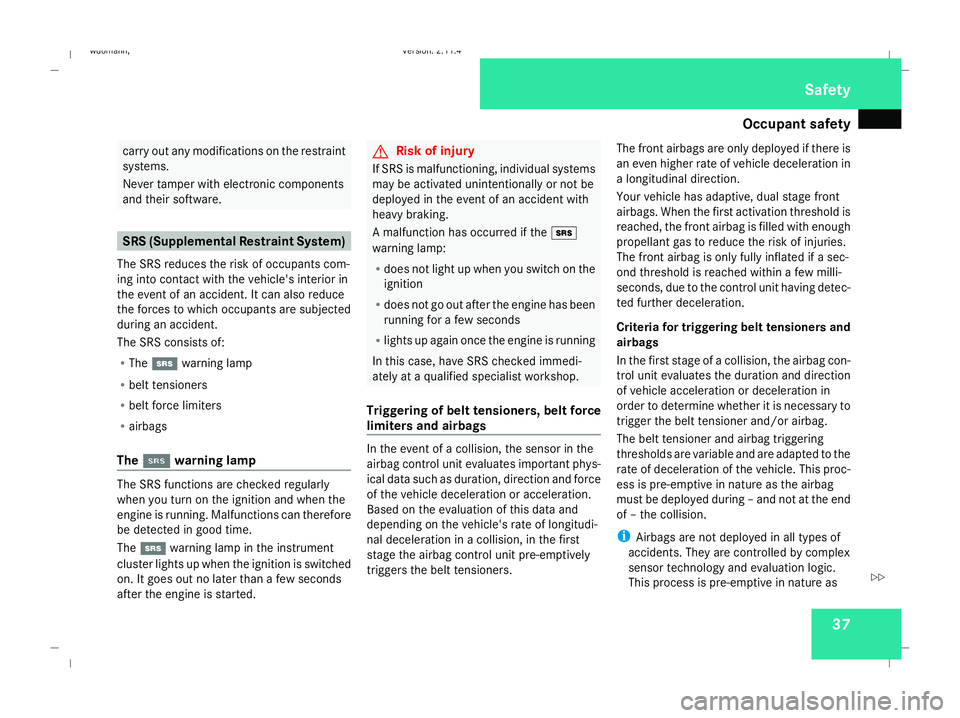
Occupant safety
37carry out any modifications on the restraint
systems.
Never tamper with electronic components
and their software.
SRS (Supplemental Restraint System)
The SRS reduces the risk of occupants com-
ing into contact with the vehicle's interior in
the event of an accident. It can also reduce
the forces to which occupants are subjected
during an accident.
The SRS consists of:
R The 1 warning lamp
R belt tensioners
R belt force limiters
R airbags
The 1 1 warning lamp The SRS functions are checked regularly
when you turn on the ignition and when the
engine is running. Malfunctions can therefore
be detected in good time.
The
1 warning lamp in the instrument
cluster lights up when the ignition is switched
on. It goes out no later than a few seconds
after the engine is started. G
Risk of injury
If SRS is malfunctioning, individual systems
may be activated unintentionally or not be
deployed in the event of an accident with
heavy braking.
A malfunction has occurred if the +
warning lamp:
R does not light up when you switch on the
ignition
R does not go out after the engine has been
running for a few seconds
R lights up again once the engine is running
In this case, have SRS checked immedi-
ately at a qualified specialist workshop.
Triggering of belt tensioners, belt force
limiters and airbags In the event of a collision, the sensor in the
airbag control unit evaluates important phys-
ical data such as duration, direction and force
of the vehicle deceleration or acceleration.
Based on the evaluation of this data and
depending on the vehicle's rate of longitudi-
nal deceleration in a collision, in the first
stage the airbag control unit pre-emptively
triggers the belt tensioners. The front airbags are only deployed if there is
an even higher rate of vehicle deceleration in
a longitudinal direction.
Your vehicle has adaptive, dual stage front
airbags. When the first activation threshold is
reached, the front airbag is filled with enough
propellant gas to reduce the risk of injuries.
The front airbag is only fully inflated if a sec-
ond threshold is reached within a few milli-
seconds, due to the control unit having detec-
ted further deceleration.
Criteria for triggering belt tensioners and
airbags
In the first stage of a collision, the airbag con-
trol unit evaluates the duration and direction
of vehicle acceleration or deceleration in
order to determine whether it is necessary to
trigger the belt tensioner and/or airbag.
The belt tensioner and airbag triggering
thresholds are variable and are adapted to the
rate of deceleration of the vehicle. This proc-
ess is pre-emptive in nature as the airbag
must be deployed during – and not at the end
of – the collision.
i Airbags are not deployed in all types of
accidents. They are controlled by complex
sensor technology and evaluation logic.
This process is pre-emptive in nature as Safety
245_AKB; 2; 7, en-GB
wdomann
,V ersion: 2.11.4
2008-10-17T11:22:31+02:00 - Seite 37 ZDateiname: 6515_1640_02_buchblock.pdf; preflight